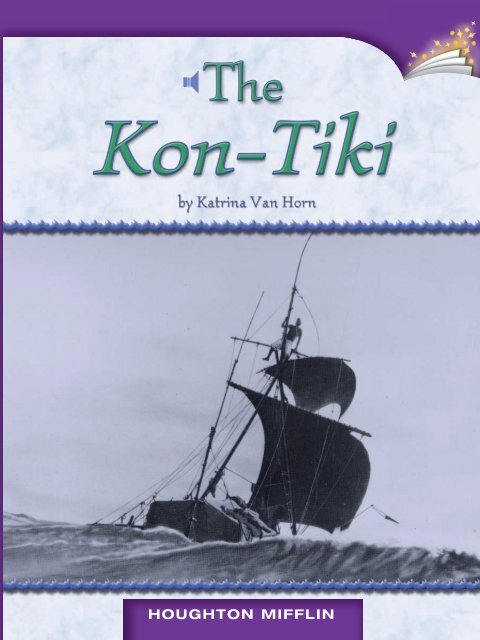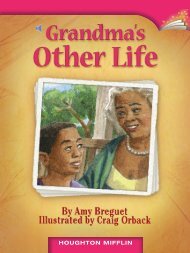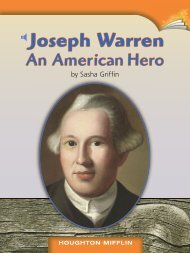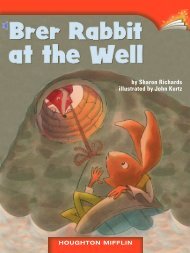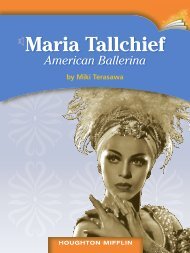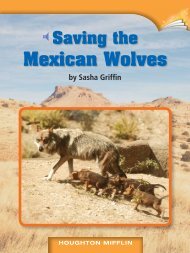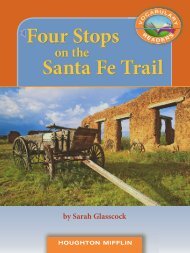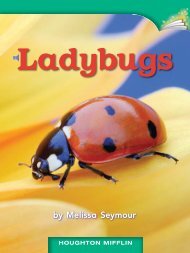Create successful ePaper yourself
Turn your PDF publications into a flip-book with our unique Google optimized e-Paper software.
HOUGHTON MIFFLIN
y Katrina Van Horn<br />
ILLUSTRATION CREDIT: Joe LeMonnier<br />
PHOTOGRAPHY CREDITS: Cover Getty Images. 1 (detail) C.3.c.8 f.371 North Carolina, titled ‘Virginiae item et Floridae’,<br />
from the Mercator ‘Atlas...’ of 1606, pub. by Jodocus Hondius, 1619 (hand coloured engraving) (see also 81957, 81958 &<br />
81959),/British Library, London, UK, © British Library Board. All Rights Reserved/<strong>The</strong> Bridgeman Art Library. 2 (l) © Digital<br />
Stock. (r) © Shutterstock. 3 (r) © Digital Stock. (b) (detail) C.3.c.8 f.371 North Carolina, titled ‘Virginiae item et Floridae’,<br />
from the Mercator ‘Atlas...’ of 1606, pub. by Jodocus Hondius, 1619 (hand coloured engraving) (see also 81957, 81958 &<br />
81959), / British Library, London, UK, © British Library Board. All Rights Reserved/<strong>The</strong> Bridgeman Art Library. (4) (l) ©<br />
Digital Stock. 4–5 Mark Downey. 5 (r) © Digital Stock. 6 (l) © Digital Stock. (r) <strong>The</strong> <strong>Kon</strong>-<strong>Tiki</strong> Museum, Oslo. 8 (l) © Digital<br />
Stock. (b) <strong>The</strong> <strong>Kon</strong>-<strong>Tiki</strong> Museum, Oslo. 9 (r) © Digital Stock. (bottom coconut) Siede Preis. (top coconut) © Shutterstock. 10<br />
( l) © Digital Stock. (b) Hulton Archive/Getty Images. 11 (r) © Digital Stock. (t) Getty Images. 12 (l) © Digital Stock. (t) ©<br />
Flip Nicklin/Minden Pictures. 13 © Digital Stock. 14 (l) © Digital Stock. (b) © Fotoreport Greeë/dpa/Corbis.<br />
Copyright © by Houghton Miffl in Company. All rights reserved.<br />
No part of this work may be reproduced or transmitted in any form or by any means, electronic or mechanical, including<br />
photocopying or recording, or by any information storage or retrieval system without the prior written permission of the<br />
copyright owner unless such copying is expressly permitted by federal copyright law. With the exception of nonprofi t<br />
transcription into Braille, Houghton Miffl in is not authorized to grant permission for further uses of this work. Permission<br />
must be obtained from the individual copyright owner as identifi ed herein. Address requests for permission to make copies<br />
of Houghton Miffl in material to School Permissions, Houghton Miffl in Company, 222 Berkeley Street, Boston, MA 02116.<br />
Printed in China<br />
ISBN-13: 978-0-547-01974-1<br />
ISBN-10: 0-547-01974-2<br />
1 2 3 4 5 6 7 8 9 RRD 15 14 13 12 11 10 09 08
2<br />
Table of Contents<br />
Introduction 3<br />
An Interesting Idea 4<br />
Building the <strong>Kon</strong>-<strong>Tiki</strong> 6<br />
Supplies for the Journey 9<br />
<strong>The</strong> <strong>Kon</strong>-<strong>Tiki</strong> Sails 10<br />
Big Adventures 11<br />
<strong>The</strong> Journey Ends 13
Introduction<br />
Some people go on trips or journeys to<br />
increase their knowledge about the world. <strong>The</strong>y<br />
may want to learn more about the past, or they<br />
may want to learn about what is happening now.<br />
Other people go on journeys to learn more about<br />
themselves. <strong>The</strong>se people want to find out how<br />
much they can achieve.<br />
Thor Heyerdahl (HAY er dahl) went on<br />
journeys for all these reasons. Thor was an<br />
explorer from Norway, in northern Europe. Thor<br />
spent most of his time planning journeys and<br />
making journeys.<br />
When Thor got the idea to build a raft and sail<br />
across the ocean, no one was surprised. But no one<br />
guessed that this journey would be one of the most<br />
famous adventures ever.
4<br />
An Interesting Idea<br />
Thor wanted to learn about everything. But<br />
one thing interested him most. He wondered how<br />
animals and people first came to live in Polynesia.<br />
Polynesia is a group of islands in the Pacific Ocean.<br />
Thor lived in Polynesia for a year during the<br />
1930s. While he was there, Thor studied the<br />
islands’ plants and animals. He saw that they were<br />
a lot like the plants and animals that live in South<br />
America. Thor started to think that these plants<br />
and animals might have floated across the ocean<br />
from South America to Polynesia.<br />
<strong>The</strong>n Thor had another idea. Maybe the first<br />
people who lived in Polynesia came from South<br />
America, too.<br />
Most scientists thought the first people in<br />
Polynesia had come from Asia, not from South<br />
America. Thor thought they were wrong. Thor<br />
wanted to show that his idea could be right.
Asia<br />
Australia<br />
Antarctica<br />
P O L Y N E S I A<br />
PA C I F I C O C E A N<br />
North<br />
America<br />
Peru<br />
Maybe the first people in Polynesia traveled there<br />
from South America.<br />
Equator<br />
South<br />
America<br />
Thor decided to travel from South America to<br />
Polynesia himself. He would not go on an airplane<br />
or a ship. Thor would travel the same way people<br />
traveled long ago would have—on a raft.<br />
5
6<br />
Building the <strong>Kon</strong>-<strong>Tiki</strong><br />
Thor went to Peru in South America. He took<br />
a crew, or group, of five other men with him. <strong>The</strong>y<br />
started to build a raft. <strong>The</strong> raft had to be strong<br />
enough to carry them across the Pacific Ocean to<br />
Polynesia. <strong>The</strong> trip would be 4,300 miles long!<br />
This drawing shows a raft made in South America<br />
hundreds of years ago.<br />
raft
Thor wanted to build a raft exactly like<br />
the rafts people in South America might have<br />
built long ago. Thor looked at old drawings<br />
from hundreds of years ago, when people from<br />
Spain, in Europe, first came to South America.<br />
<strong>The</strong> drawings showed what rafts from long ago<br />
looked like.<br />
Thor and his crew made their raft from<br />
balsa wood. Balsa is a kind of tree that grows<br />
in South America. <strong>The</strong> crew tied together nine<br />
balsa trees that they had cut down. This was the<br />
bottom of the raft. <strong>The</strong> crew put smaller balsa<br />
logs on top of the big trees to make the top of<br />
the raft.
8<br />
<strong>The</strong>n Thor and his crew made a mast and a sail<br />
for the raft. <strong>The</strong> sail would catch the power of the<br />
wind to move the raft. <strong>The</strong> crew made a giant oar,<br />
so they could row the raft when there was no wind<br />
blowing into the sail.<br />
Finally, the crew built a cabin in the back<br />
section, or part, of the raft. <strong>The</strong> men could go in<br />
the cabin when there was bad weather.<br />
Thor named the raft <strong>Kon</strong>-<strong>Tiki</strong>. It was the name<br />
of a leader in Peru who used a balsa raft to escape<br />
from his enemies, hundreds of years ago.<br />
the bottom of the <strong>Kon</strong>-<strong>Tiki</strong><br />
<strong>The</strong> crew made the bottom of the <strong>Kon</strong>-<strong>Tiki</strong> from trees.
Supplies for the Journey<br />
Thor and his crew took many supplies with<br />
them on their journey. Fresh water was most<br />
important. <strong>The</strong> crew couldn’t stay alive for long<br />
without water to drink. <strong>The</strong>y used hollow pieces<br />
of wood as tanks to hold the water. <strong>The</strong> crew also<br />
brought fruit, sweet potatoes, and some foods<br />
in metal cans. <strong>The</strong>y knew they could catch fish<br />
during the journey.<br />
<strong>The</strong> crew had two kinds of modern equipment:<br />
a radio and watches. <strong>The</strong>y could use the radio<br />
to call people on land if they needed help. <strong>The</strong>y<br />
could use the watches to tell time. One member of<br />
the crew knew how to navigate by looking at the<br />
sun, moon, and stars. To navigate means to know<br />
the correct way to go.<br />
coconuts<br />
9
10<br />
<strong>The</strong> <strong>Kon</strong>-<strong>Tiki</strong> Sails<br />
On April 28, 1947, the <strong>Kon</strong>-<strong>Tiki</strong> left South<br />
America and started sailing toward Polynesia.<br />
After the <strong>Kon</strong>-<strong>Tiki</strong> got far out in the ocean, the raft<br />
was carried by a strong current. Currents are parts<br />
of the ocean that move faster than other parts.<br />
Thor knew that this current was the same one that<br />
carried plants and animals from South America to<br />
Polynesia long ago.<br />
A crew member<br />
climbed near the<br />
<strong>Kon</strong>-<strong>Tiki</strong>’s sail.<br />
sail
cabin<br />
mast<br />
<strong>The</strong> <strong>Kon</strong>-<strong>Tiki</strong> and its crew sailed across the ocean.<br />
sail<br />
Big Adventures<br />
One day when the <strong>Kon</strong>-<strong>Tiki</strong> was far out in the<br />
ocean, the crew saw a whale shark. <strong>The</strong>n the shark<br />
went under the raft. <strong>The</strong> crew saw the slopes of<br />
the whale’s back on both sides of the raft! It was<br />
a huge and dangerous animal. If the shark moved<br />
suddenly, it could make a huge wave. <strong>The</strong> wave<br />
could hit the raft like a giant avalanche of water.<br />
A big wave could break the raft and knock the crew<br />
into the water!<br />
11
12<br />
whale shark<br />
A whale shark like this one almost stopped the <strong>Kon</strong>-<strong>Tiki</strong>’s<br />
journey!<br />
<strong>The</strong> shark started to swim around the raft.<br />
<strong>The</strong> raft had to come to a halt, or stop. It couldn’t<br />
move until the shark swam away. Luckily, the<br />
shark never hurt the raft or the crew. Maybe that<br />
giant shark was just being friendly!
<strong>The</strong> Journey Ends<br />
Thor and his crew sailed on the raft for three<br />
months. <strong>The</strong>n one day, they saw birds flying at<br />
high altitudes in the sky. That was a clue that land<br />
was near. And on July 30, the crew saw land. It<br />
was Polynesia!<br />
When the <strong>Kon</strong>-<strong>Tiki</strong> approached the islands,<br />
people came in boats to meet Thor. <strong>The</strong> people<br />
looked at the raft. <strong>The</strong> people asked, “Where’s the<br />
engine?” <strong>The</strong> crew told them that there was no<br />
engine. <strong>The</strong> people were amazed that the <strong>Kon</strong>-<strong>Tiki</strong><br />
had traveled so far without an engine!<br />
People around the world heard about the<br />
journey. Thor wrote a popular book about his<br />
journey. But did Thor succeed in proving what<br />
Thor wanted to prove? Did he show that the first<br />
people in Polynesia came from South America?<br />
13
Well, no. Thor did not really prove his idea<br />
was true. Most scientists still thought Thor’s idea<br />
was wrong. Scientists still believed people first<br />
traveled to Polynesia all the way from Asia, not<br />
from South America.<br />
But today everyone agrees about one<br />
thing. <strong>The</strong> <strong>Kon</strong>-<strong>Tiki</strong>’s journey was an incredible<br />
adventure, and Thor Heyerdahl was a brave and<br />
daring explorer.<br />
Thor Heyerdahl<br />
Thor Heyerdahl stood in front of the <strong>Kon</strong>-<strong>Tiki</strong> years after<br />
his journey.<br />
14
Responding<br />
TARGET SKILL Text and Graphic<br />
Features How did text and graphic<br />
features help you understand this story?<br />
Copy the chart below. Complete the chart<br />
by writing the purpose of the other two<br />
features in this book.<br />
Maps Drawings Headings<br />
Help me see<br />
where the<br />
story takes<br />
place.<br />
? ?<br />
Write About It<br />
Text to Self Imagine you are a crew<br />
member on the <strong>Kon</strong>-<strong>Tiki</strong>. Write a fictional<br />
story telling what it was like to sail to<br />
Polynesia. Use descriptive words to help<br />
readers picture what happens on the raft.<br />
15
16<br />
altitude<br />
approached<br />
avalanche<br />
equipment<br />
halt<br />
TARGET VOCABULARY<br />
increase<br />
section<br />
slopes<br />
succeed<br />
tanks<br />
TARGET SKILL Text and Graphic Features<br />
Tell how words, photos, and art work together.<br />
TARGET STRATEGY Infer/Predict Use clues to<br />
figure out more about the selection.<br />
GENRE Informational text gives factual<br />
information about a topic.
Level: O<br />
DRA: 38<br />
Genre:<br />
Informational Text<br />
Strategy:<br />
Infer/Predict<br />
Skill:<br />
Text and Graphic Features<br />
Word Count: 1,201<br />
3.5.<strong>25</strong><br />
HOUGHTON MIFFLIN<br />
Online Leveled Books<br />
ISBN-13: 978-0-547-01974-1<br />
ISBN-10: 0-547-01974-2<br />
1031853


